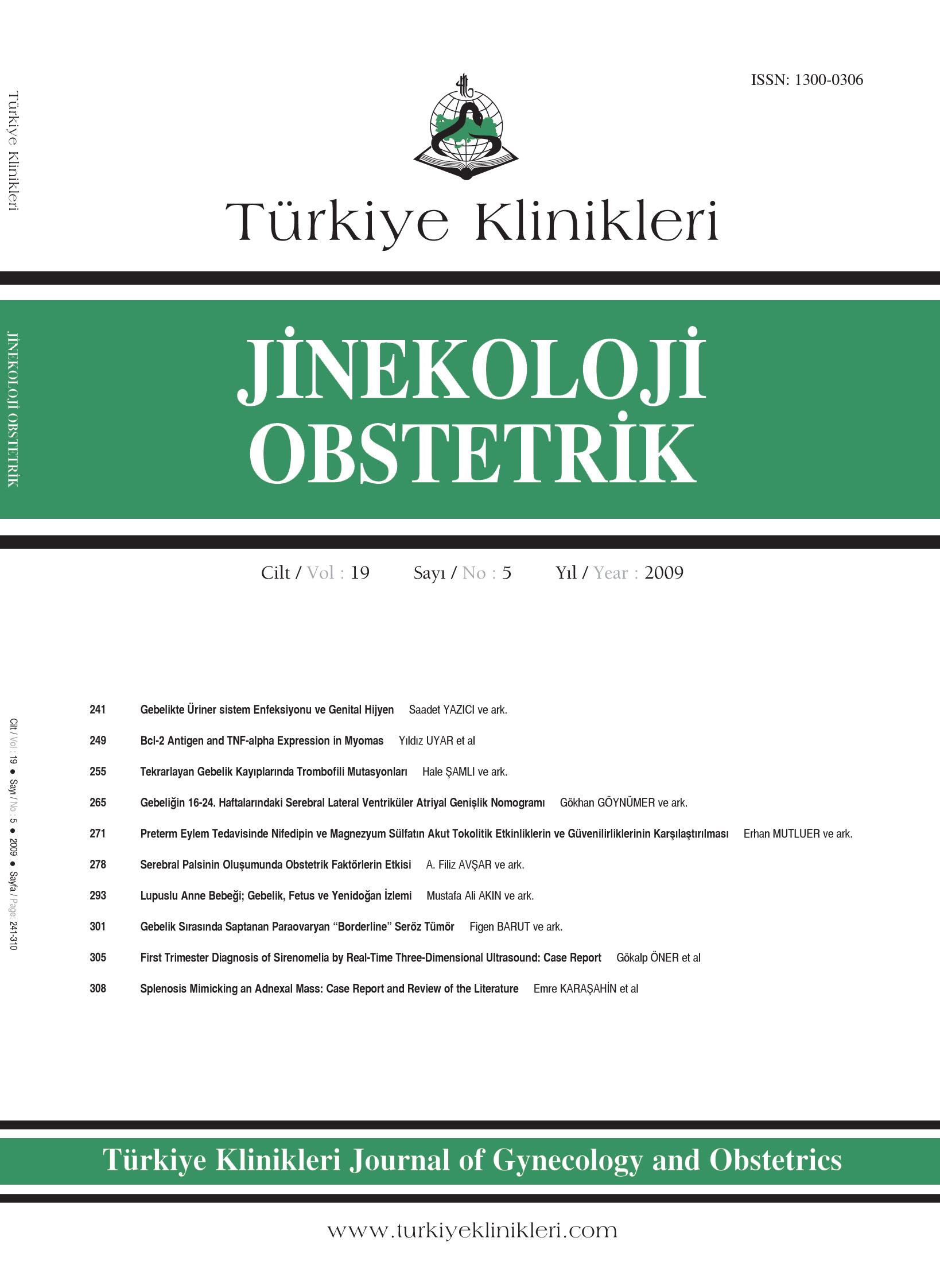Open Access
Peer Reviewed
REVIEW
3217 Viewed1193 Downloaded
Obstetric Factors in the Evolution of Cerebral Palsy: Review
Serebral Palsinin Oluşumunda Obstetrik Faktörlerin Etkisi
Turkiye Klinikleri J Gynecol Obst. 2009;19(5):278-92
Article Language: TR
Copyright Ⓒ 2025 by Türkiye Klinikleri. This is an open access article under the CC BY-NC-ND license (http://creativecommons.org/licenses/by-nc-nd/4.0/)
ÖZET
Serebral palsi çocukluk çağının en sık görülen, yaşam boyu süren, hareket ve postürü etkileyen kalıcı gelişimsel bir bozukluğudur. Bir hastalık değil, ilerleyici olmayan, motor fonksiyon kaybı gösteren, birçok farklı etiyoloji ve nörolojik bozuklukları içeren bir tanımdır. SP prevalansı ortalama 1000 canlı doğumda 1.1-2'dir. Etiyolojisinde antepartum (%60-80), intrapartum (%3-13) ve postpartum (%10) nedenler olabilir. Son yıllarda SP'nin etiyolojisi ile ilişkili düşüncelerimizde radikal değişiklikler olmuştur. İntrapartum asfikside olduğu gibi tek bir nedenin olduğu basit teorilerden uzaklaşılarak nedenin birbirine katkıda bulunan olaylar zinciri olabileceğine yönelinmiştir. Doğum eylemi sırasında veya doğumda annenin takibi ve verilen bakımın kalitesi ve doğruluğu ile bebeğin ölümü veya yaşayan çocukta SP gelişimi arasındaki ilişki ve SP gelişiminin önlenebilirliği konuları halen obstetrisyen, pediatrist, ebeveyn ve hukukçular arasında tartışma konusu olmaya devam etmektedir. SP gelişiminin tamamen önlenmesi mümkün değildir, ancak SP olgularında intrapartum asfiksinin etiyolojide yer aldığı %8-10'luk grup ile antenatal patolojilerin bir kısmı obstetrisyenin önleme için strateji geliştirilebileceği gruptur ve obstetrisyenin etkisinin olabileceği oran ancak bununla sınırlıdır. Mümkün olan en fazla sayıda olgunun önlenebilmesi amacıyla, önemli olan çocuk hastalıkları uzmanı ile obstetrisyenin iş birliği içinde çalışması, düzenli gebelik takibi ve perinatal dönem patolojilerinin mümkünse önlenmesi veya erken tanısının sağlanmasıdır.
Serebral palsi çocukluk çağının en sık görülen, yaşam boyu süren, hareket ve postürü etkileyen kalıcı gelişimsel bir bozukluğudur. Bir hastalık değil, ilerleyici olmayan, motor fonksiyon kaybı gösteren, birçok farklı etiyoloji ve nörolojik bozuklukları içeren bir tanımdır. SP prevalansı ortalama 1000 canlı doğumda 1.1-2'dir. Etiyolojisinde antepartum (%60-80), intrapartum (%3-13) ve postpartum (%10) nedenler olabilir. Son yıllarda SP'nin etiyolojisi ile ilişkili düşüncelerimizde radikal değişiklikler olmuştur. İntrapartum asfikside olduğu gibi tek bir nedenin olduğu basit teorilerden uzaklaşılarak nedenin birbirine katkıda bulunan olaylar zinciri olabileceğine yönelinmiştir. Doğum eylemi sırasında veya doğumda annenin takibi ve verilen bakımın kalitesi ve doğruluğu ile bebeğin ölümü veya yaşayan çocukta SP gelişimi arasındaki ilişki ve SP gelişiminin önlenebilirliği konuları halen obstetrisyen, pediatrist, ebeveyn ve hukukçular arasında tartışma konusu olmaya devam etmektedir. SP gelişiminin tamamen önlenmesi mümkün değildir, ancak SP olgularında intrapartum asfiksinin etiyolojide yer aldığı %8-10'luk grup ile antenatal patolojilerin bir kısmı obstetrisyenin önleme için strateji geliştirilebileceği gruptur ve obstetrisyenin etkisinin olabileceği oran ancak bununla sınırlıdır. Mümkün olan en fazla sayıda olgunun önlenebilmesi amacıyla, önemli olan çocuk hastalıkları uzmanı ile obstetrisyenin iş birliği içinde çalışması, düzenli gebelik takibi ve perinatal dönem patolojilerinin mümkünse önlenmesi veya erken tanısının sağlanmasıdır.
ABSTRACT
Cerebral palsy is the most frequent, lifelong, permanent developmental failure of the childhood that effects the motion and posture. It is not an illness but a definition of a non-progresive, motor function deficiency that encompasses different etiologies and neurological dysfunctions. The prevalence of CP is 1,1-2 in 1000 live births. Antepartum (60-80%), intrapartum (3-13%) and postpartum (10%) causes can be sought in its etiology. In recent years there have been radical changes about CP's etiological causes. Receding from simple teories that includes a single causative like intrapartum asphyxia, a chain of consecutive additive events is more likely. It is still an ongoing debate whether there is an association between child mortality and development and prevention of SP in the alive child in regards to the accuracy and the quality of the intrapartum care of the mother between obstetrician, pediatricans, parents and lawyers. It is impossible to prevent CP altogether, but though limited, obstetricans can implement strategies to prevent intrapartum asphyxia group that constitutes 8-10% of CP etiologies and some of the antenatal pathologies. The collaboration of the obstetrican and the pediatrician, regular pregnancy follow up and the prevention and the early diagnosis of the pathologies of the perinatal period are important in the prevention of CP as much as possible.
Cerebral palsy is the most frequent, lifelong, permanent developmental failure of the childhood that effects the motion and posture. It is not an illness but a definition of a non-progresive, motor function deficiency that encompasses different etiologies and neurological dysfunctions. The prevalence of CP is 1,1-2 in 1000 live births. Antepartum (60-80%), intrapartum (3-13%) and postpartum (10%) causes can be sought in its etiology. In recent years there have been radical changes about CP's etiological causes. Receding from simple teories that includes a single causative like intrapartum asphyxia, a chain of consecutive additive events is more likely. It is still an ongoing debate whether there is an association between child mortality and development and prevention of SP in the alive child in regards to the accuracy and the quality of the intrapartum care of the mother between obstetrician, pediatricans, parents and lawyers. It is impossible to prevent CP altogether, but though limited, obstetricans can implement strategies to prevent intrapartum asphyxia group that constitutes 8-10% of CP etiologies and some of the antenatal pathologies. The collaboration of the obstetrican and the pediatrician, regular pregnancy follow up and the prevention and the early diagnosis of the pathologies of the perinatal period are important in the prevention of CP as much as possible.
MENU
POPULAR ARTICLES
MOST DOWNLOADED ARTICLES





This journal is licensed under a Creative Commons Attribution-NonCommercial-NoDerivatives 4.0 International License.










